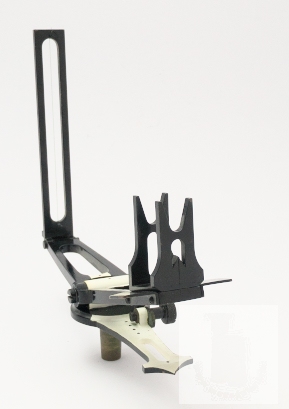Leitz 7x50
Dänisches PeilvisierDas 7x50 Monokular hier ist die linke Fernglashälfte eines Leitz Marsept-Modells und diente der dänischen Marine als Peilvisier. Die dänische Marine hat offenbar viele vorhandene oder erhältliche Ferngläser für diesen Zweck konvertiert, denn es sind auch andere monokulare Hälften von Beck Kassel, Carl Zeiss u. a. bekannt. Entsprechend ist die Grundbauweise der Peiloptiken recht ähnlich, wenn auch in individuell genutzten und angepassten Einzelteilen nicht identisch.An der vorderen Seite des Aufbewahrungskasten aus Holz ist ein kleines Blechschild aufgeschraubt. Darauf sieht man eine Dänische Krone und die Buchstaben "FK" als Abkürzung für "Flådens Kompasmagasin", das Kompasszeugamt der Dänischen Marine. Daneben ist die Abnahmenummer 27 eingestempelt. Das 7x50 ist die linke Hälfte eines unvergütetes Porro-1-Modell "Marsept" mit konischem Objektivtubus (vgl. "Momar" 7x50. Die zweifach verschraubten Deckel sind schwarz lackiert, der obere beschriftet mit 7x50 und Marsept im Leitz-Logo, der untere mit der Krone M und Nr. 2434. Das Gehäuse hat eine eingegossene Trageriemenöse und ist, wie der Objektivtubus, mit Hartgummi ummantelt. Die Augenmuschel ist aus Kunststoff, die Dioptrienskals am rechtsseitigem Okular läuft komplett um die Okularhülse und ist bei null und +/- Fünf markiert. |
Danish Director SightThis 7x50 monocular is the left half of a Leitz Marsept-binoculars and served as a director sight of the Danish Navy. The Danish Navy obviously used surplus or available binoculars for this purpose, as there are also other monocular halves by Beck Kassel, Carl Zeiss etc. Hence the basic cosntruction of these director sights are rather similar even if not identical in some used and adapted parts.On the front of the wooden storage box is a small screwed-on tin plate. It is inscribed with the Danish crown and the letters "FK". This is the abbreviation of "Flådens Kompasmagasin", the compass arsenal of the Danish Navy. There also is the acceptance number 27. The 7x50 is the left half of an uncoated Porro 1 model "Marsept" with a conical objective tube (cf. "Momar" 7x50. The cover plates have two screws and are painted black. The upper cover is amrked 7x50 and Marsept within the Leitz-Logo, the lower cover is marked with a crown, an M and "Nr. 2434". The housing has a cast-in strap-lug and is covered with hard rubber. So is the obejctive tube. The eyecup is made of plastic, the dioptre scale on the right-hand sided eyepiece runs fully around the ocular. It is marked at zero and +/- five. |
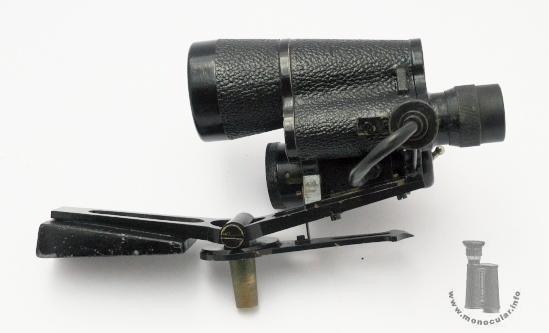
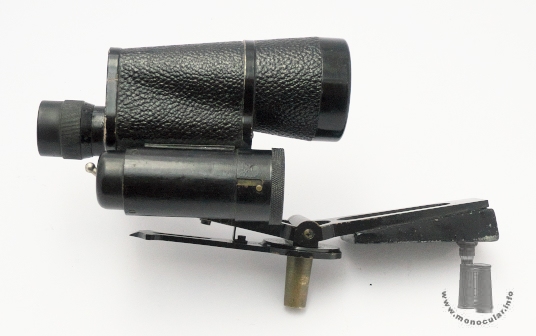
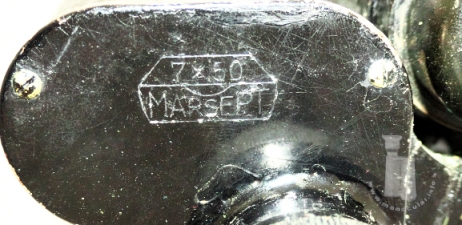
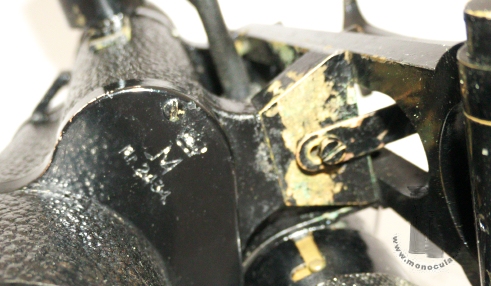

| Das Peilvisier ist mit einer Fadenkreuz-Strichplatte und einer Beleuchtungseinheit aus einem zylindrischen Batteriebehälter mit Stromschalter und Verschlussdeckel sowie ein Kabel mit Glühbirnenfassung ausgerüstet. Andere Konstruktionsmerkmale entsprechen annähernd denen des Beck 8x40. Das Visierunterteil ist unten nur mit eine "5" gekennzeichnet (Teilenummer?). Das originär leicht kippbare Visierunterteil wurde am vorderen Brückenfuß mit einer Metallippe mit geringen Spielraum befestigt (s. Bild 4). Der vordere Rahmen hat unten ein Gegengewichte. |
The monocular sight comes with a cross-hair reticle and an illumination unit constiting of a cylindrical battery container with a power switch and cap as well as of a cable with a bulb hosuing. Further design features are nearly the same as those of the Beck 8x40. The mounting part of the sight has a "5" stamped on its bottom (a part number?). The originally slightly tiltable part is screwed on to the front bridge foot with a metal strip giving some space to move (see pic. 4). The front metal frame has counterweight attached to its bottom.. |
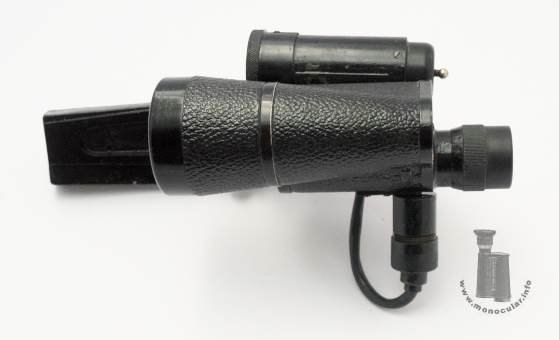
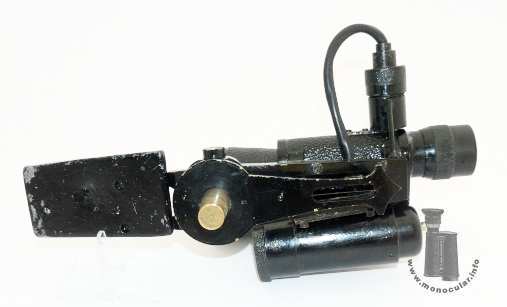
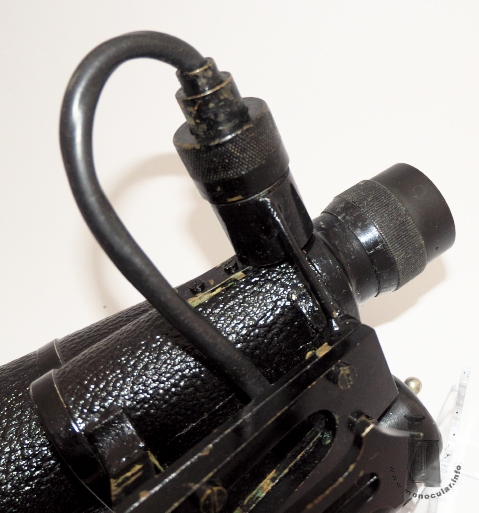
| Der Kasten für das Peilvisier enthält auch ein analoges Peilvisier, dessen oberes Teil sich kippen lässt. An der Vorderseite kann ein länglicher Metallrahmen hochgeklappt werden; diese hat einen senkrechte Visierdraht und eine nach vorne zeigende Spitze mit einem Peilstrich. Am hinteren Teil sind zwei Peilstücke mit jeweils zwei Zinken aufgeschraubt. Beide fungieren als eine Art "Kimme und Korn". Auf der oberen Seite ist eine weiße Leuchtfarbe angebracht. | The box for the sight also contains an analogue director sight, the upper part of which can be tilted. An elongated metal frame can be folded up at the front; this has a vertical sighting wire and a forward-pointing tip with a sighting line. Two gauges, each with two prongs, are screwed onto the rear part. Both act as a sort of "bead and sight". A white luminous paint is applied to the upper side. |

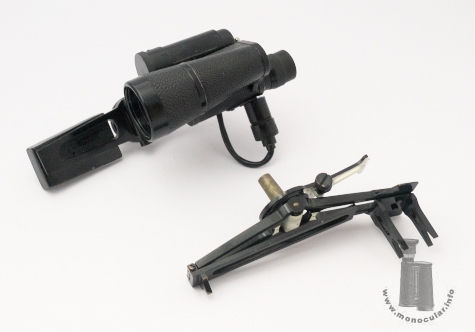
| Das 7x50 Monokular ist 174-180 mm lang, das Gehäuse ist oben 60 x 60 mm und unten 60 x 70 mm breit, das Okularstück ist 32 mm, der Fokussierungsring 36,5 mm und die Augenmuschel 35 mm im Durchmesser. Der Objektivtubus verbreitert sich von 53 auf 62 mm im Durchmesser. Das monokulare Peilvisier mit der Montage und Beleuchtungseinheit wiegt 1962 g. Das analoge Visier wiegt 838 g. Der 10 cm lange Batteriebehälter ist 39 mm im Durchmesser und das 4 cm lange Lampengehäuse 25 mm im Durchmesser. Das Montageunterteil ist 225 mm lang. Der Stativzapfen ist 33 mm lang. | The 7x50 monocular is 174-180mm long, the body is 60 x 60mm wide at the top and 60 x 70mm at the bottom, the eyepiece is 32mm, the focusing ring is 36.5mm and the eyecup is 35mm in diameter. The objective tube increases from 53 to 62 mm in diameter. The monocular sight with its assembly and lighting unit weighs 1962 g. The analogue sight weighs 838 g. The 10 cm long battery case is 39 mm in diameter and the 4 cm long lamp housing is 25 mm in diameter. The mounting base is 225 mm long. The tripod rod is 33 mm long. |
Fotos: Zeun
